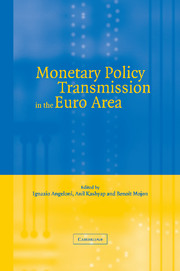 Monetary Policy Transmission in the Euro Area
Monetary Policy Transmission in the Euro Area Published online by Cambridge University Press: 22 September 2009
Introduction
There is little doubt that central bankers pay considerable attention to the activities of commercial banks and other financial intermediaries. So in a survey of eighty-nine central banks on the key ingredients for a successful monetary framework, Fry et al. (2000) found that out of twenty-one possible factors ‘analysis of the banking sector’ came seventh on average, even ranking ahead of ‘analysis of the real sector’. Of course central banks will usually have an interest in the behaviour of financial intermediaries for financial stability reasons and indeed ‘analysis of domestic financial stability’ was ranked fifth on average in the same survey. But even for the sixteen central banks that cited an inflation target as the most important ingredient and for whom understanding the transmission mechanism would be key, the categories relating to the banking sector received high ranking.
The traditional textbook models that are routinely used for the analysis of monetary policy, such as IS-LM, usually do not spell out the assumptions that underpin the transmission mechanism and, in so far as they do, they usually pay little attention to the role of financial intermediaries. New Keynesian models of the sort set out in Clarida, Galí and Gertler (1999) often build on more explicit microfoundations, and usually assume that capital markets are free of frictions and complete. In such a world the behaviour of financial intermediaries would be of only rather limited interest.
To save this book to your Kindle, first ensure [email protected] is added to your Approved Personal Document E-mail List under your Personal Document Settings on the Manage Your Content and Devices page of your Amazon account. Then enter the ‘name’ part of your Kindle email address below. Find out more about saving to your Kindle.
Note you can select to save to either the @free.kindle.com or @kindle.com variations. ‘@free.kindle.com’ emails are free but can only be saved to your device when it is connected to wi-fi. ‘@kindle.com’ emails can be delivered even when you are not connected to wi-fi, but note that service fees apply.
Find out more about the Kindle Personal Document Service.
To save content items to your account, please confirm that you agree to abide by our usage policies. If this is the first time you use this feature, you will be asked to authorise Cambridge Core to connect with your account. Find out more about saving content to Dropbox.
To save content items to your account, please confirm that you agree to abide by our usage policies. If this is the first time you use this feature, you will be asked to authorise Cambridge Core to connect with your account. Find out more about saving content to Google Drive.